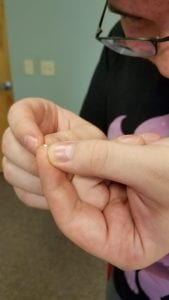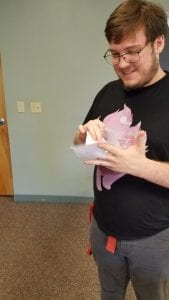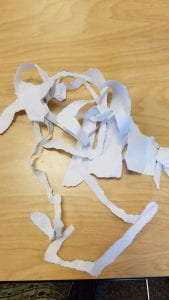Score:
The Sound of Sharing
Take a blank 8.5 by 11 white sheet of paper.
Find a partner.
Tear off a piece of the paper to hear its fibers.
Hide your pieces but share the remaining paper.
Have your partner do the same.
Continue tearing to never make the sound end.
Artist Statement:
With my score “The Sound of Sharing”, I am experimenting with human sociological behavior. Humans naturally have evolved to be either altruistic or egoistic. However, commonly within today’s business-oriented power-driven society, egoistic individuals have found it easier to achieve. The feeling of altruism is intuitively a humane trait, which I would love my audience to re-experience, that of a place with humility and humble beginnings. When presenting the audience with the dilemma of tearing paper without no end, which could be taken literally or figuratively, I am waiting to see if the rules of “hiding your piece” would be broken, and if the activity will end when all the paper is torn into pieces that can’t be torn anymore. In essence, it is a test between individuals — when one has a large amount of resources, would one share them for the sake of keeping the deprived content? And a more philosophical question, when the tearing stops and the resources completely depleted, what happens then?
This activity draws some inspiration from Fluxus artist Yoko Ono in the way common household objects are the medium for the activity. Using terms such as “tear”, “hide”, “hear” create a powerful, vague, yet satisfying action for the audience to experience, words that derive meaning with the flexibility of intention. I have specifically chose to use tearing paper as the activity, as though a seemingly boring activity, I try to appeal to the satisfaction of the human impulse through action. It is therapeutic in a way to see impulsive action be immediately rewarded with an expected result. I chose a specific form of paper, the 8.5 by 11 standard white paper, for all of the characteristics that paper is represented to be. It could be taken as a form of breaking restrictions from the norm — the white paper is meant to be printed on, used for assignments, school, and anything corporate. “Tearing” that is a way of straying from the norm that confines us in society. The paper is also is blank, white, empty, and meaningless, yet if the audience has the capacity to create value and share “nothing”, then they would have the capacity to share anything.
Design Iterations and Testing
Initially the piece was tested in a large classroom with a large number of students, but the intended effect of sharing was not implemented. Therefore, I limited the activity to just two people and pairs. The line “Find a neighbor” is now changed to “Find a partner”, limiting the activity to two people.
The biggest problem with the score was the line “Hide your piece but share the remaining paper”. Many groups hid only one piece, and then stopped hiding the rest of the pieces, and assumed it was only supposed to be done once. As a result, I’ve clarified it by changing it to “Hide your pieces”, making it known that you should be keeping all of your pieces.
The results:
My ideal results were two endings, where the first would be the activity ending with a very very small piece of paper that could no longer be torn, but with the participants leaving the large pieces that were “hidden” alone. This had happened twice with many iterations.


The second result was when the piece was no longer able to be torn, the participants would tear up all of the remaining paper until every bit was torn. This is the ideal result I wanted to see from the piece.
An interesting third result was displayed which had interesting implications. Participants would tear the paper in a loop-like way to avoid tearing off a piece, but continue one long strip to maximize the amount of “tearing” that could be possible. I find it an ingenious way of problem solving and thinking to create a way to create as much sound as possible without losing the integrity of tearing off pieces. In my opinion, this third result goes to show the mental capacity of participants who enjoy thinking out of the box for solutions, rather than accepting the proposal that I gave.

